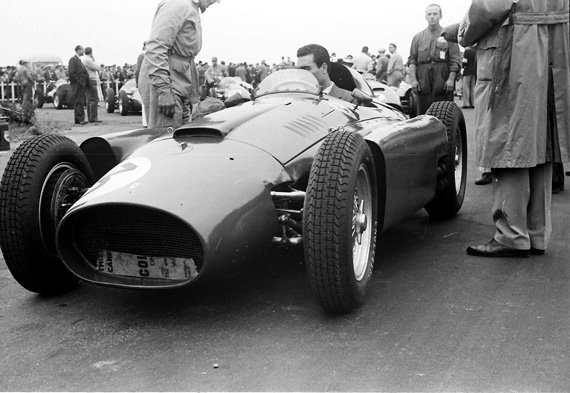
Eugenio Castellotti at the wheel of the Lancia-Ferrari at the 1956 British Grand Prix at Silverstone.
Story and photos by Graham Gauld
There are times when we can all be rather pretentious. I fell into that trap thirty years ago when I had the idea of writing a subjective book on the psychology of the racing driver. I have always had an interest in the variety of people who come into motor sport and what makes them tick. I had read a lot about psychology in general, then dropped the idea when I realized what a fool I might have made of myself. However, if Central Casting in Hollywood were ever asked for a “racing driver type” back in the 1950s, they would have to have chosen Eugenio Castellotti.
I watched Castellotti race many times and at the wheel he could appear to be in a trance, his eyes languidly staring straight ahead, but his body language all action. It was his custom to monster it as soon as the flag came down, often outrunning many of the accepted champions, but he tended to be hard on the car and Castellotti was usually one of the first to change tires.
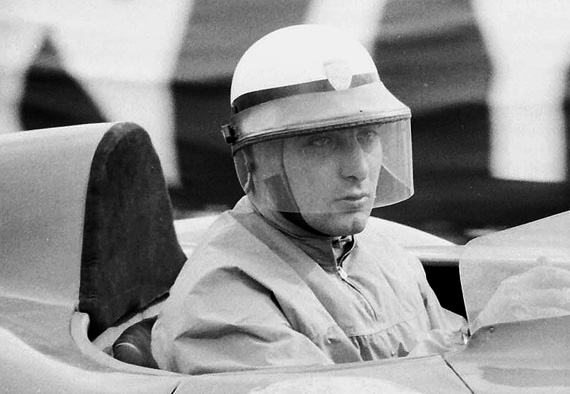
A close-up of Castellotti at Dundrod in 1955, concentrating hard while accelerating away from the hairpin in the Ferrari 850 Monza.
Eugenio Castellotti was born in Lodi in 1930 and was rich, dashing, and handsome. Though he came from a titled Italian family, they did not support his passion for motor racing. However, at the tender age of 20 he bought a brand new Ferrari 166 barchetta (0058M) from a dealer in Genoa just in time to compete in the Tour of Tuscany. (It has been the suggestion that in fact he did not actually buy the car until after the Tuscan event and that the Genoa dealer Sig. Braida was the entrant and that Castellotti bought the car later).
His next event was the Mille Miglia in 1950, his car being entered by Scuderia Guastella which continued to enter him in events until August 1952 when he won the Circuito di Senegallia in his 166 barchetta that was now two years old. Scuderia Guastella entered Castellotti for the Monaco Sports Car race in 1952 and he finished second to teammate Vittorio Marzotto but this time in a 225S ( Chassis 0166ED).
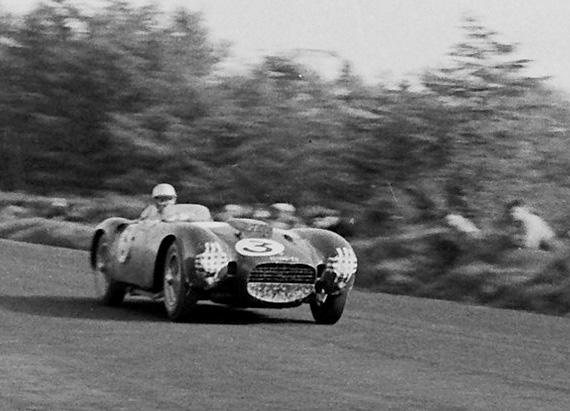
Eugenio Castellotti at the wheel of the Lancia D24 sports car in the 1954 Tourist Trophy race at Dundrod in Ireland.
However, it was not Ferrari who approached Castellotti to be a factory driver in 1953, but Ferrari’s great rivals Lancia who entered him for the Pan American Road race, and he repaid them by finishing third in a Lancia D23.
The following year he was one of a stellar team of Lancia drivers (Fangio, Taruffi, Ascari, and Villoresi) in the factory D24s. It was driving a D24 at the Dundrod Tourist Trophy race of ’54 that I first saw Castellotti race. He was very much the junior driver in the team and so was entered as reserve to drive each of the four factory cars in the race. The best placed Lancia finished 6th.
During 1954 Lancia had also developed a Grand Prix car which was given to Alberto Ascari for the Spanish Grand Prix that year, but for 1955 they mounted a major effort with three factory Lancias for Ascari, Villoresi, and Castellotti as drivers. For Castellotti success came early with a strong second place in the Monaco Grand Prix, but in the same race he had also seen his close friend and mentor, Ascari, go off the road and into the harbor where he was rescued by frogmen. Relieved, that Alberto was not seriously injured, Castellotti and Ascari returned to Milan.
Four days later Castellotti was out testing the unpainted Ferrari 750 Monza at Monza before the Supercortemaggiore race when Ascari turned up to watch. Eugenio was pleased to see Ascari, who asked whether he could have a few laps in the car. Castellotti loaned Ascari his helmet and three laps later Ascari lay dead on the track at the fast Vialone Curve at the back of the circuit. He had been thrown out and killed. Castellotti was grief stricken and at the huge funeral that took place in Milan a few days later, Castellotti was one of the pall bearers who carried Ascari’s coffin.
Gianni Lancia had decided to wind up the Grand Prix program after the Belgian Grand Prix and the cars were transferred to Scuderia Ferrari. Castellotti now had his first factory Grand Prix drive for the Scuderia at the Dutch Grand Prix where he finished fifth. He continued to race for Ferrari until 1957.
Meanwhile a new young Italian driver was challenging Castellotti, Luigi Musso, and he and Castellotti were to become great rivals, particularly as both raced for Scuderia Ferrari.
Though Musso was married, Castellotti was still attracting lots of girlfriends but during 1956 one of them became very special; Delia Scala, the Italian film actress. Their relationship blossomed during 1956 and, as was well known, Enzo Ferrari was not sympathetic to the social lives of his drivers – particularly if women were involved. In Italy, however, the handsome racing driver who raced for Ferrari and the beautiful film actress was a story made in heaven.
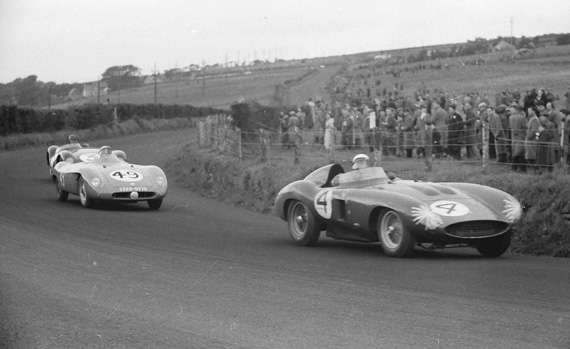
At Dundrod in 1955, Castellotti leads the DB-Panhard HBR of Claude Storez and the Cooper-Jaguar of Peter Whitehead.
For the 1957 season Enzo Ferrari decided to retain the Lancia V8 engines but put them into a new Formula 1 car called the 801 with a completely new chassis. Castellotti was one of the team of drivers who drove it in Argentina but he retired when a hub overheated and a wheel came off. He then went off on holiday with Delia Scala only to receive a telephone call from Enzo Ferrari, who knew that Castellotti was not far away in Florence, ordering him back to Modena to test some other modifications to the 801 at the Autodrome.
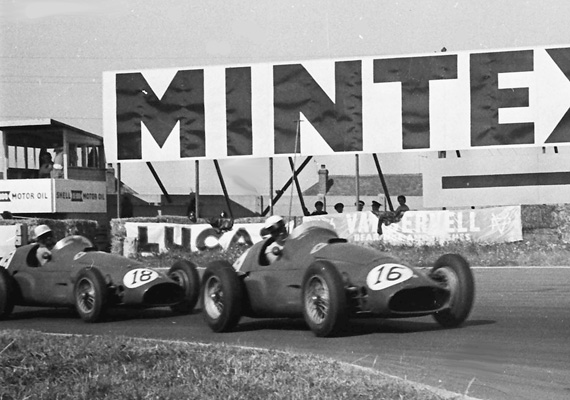
Castellotti trying hard with the Ferrari 625 in the 1955 British Grand Prix at Aintree ahead of teammate Maurice Trintignant.
He got up at dawn and drove over the Raticosa and Futa passes to Bologna and thence to Modena. When he arrived at the circuit the car was already there. It turned out that Jean Behra had broken the lap record at Modena Autodrome testing a 250F Maserati and Ferrari felt that the lap record was traditionally his, hence the test session and Enzo Ferrari was on hand to watch. Castellotti warmed up the car and then set off for a quick lap, only to misjudge the first chicane which at the time was lined with small bushes and a solid grandstand. The Lancia-Ferrari bounced off one of the red and white kerb stones and Castellotti was thrown out against a concrete pillar and killed.
For the Italians they had lost a hero, and the press laid part of the blame on Ferrari for breaking up Castellotti’s holiday, but Ferrari countered by saying that Castellotti had been in a bad mood (understandable) and inferred that Eugenio had let a woman influence him so much.
Only a few short weeks later came the Mille Miglia where Castellotti’s seat was given to the veteran Piero Taruffi. Taruffi followed in Castellotti’s footsteps and won the Mille Miglia for Ferrari; but at what cost? Alfonso de Portago and Ed Nelson in a sister car were involved in an accident that claimed the lives of a lot of spectators, and the Mille Miglia as a completely free and open road race on public roads, ended once and for all.
History has a habit of remembering only the winners. Eugenio Castellotti never won a single Grand Prix, but was the archetypal Grand Prix driver who stood on the fringe of greatness. Through his career his impetuousness too often caught him out; it was probably so at Modena that day, March 14, 1957, when he died.
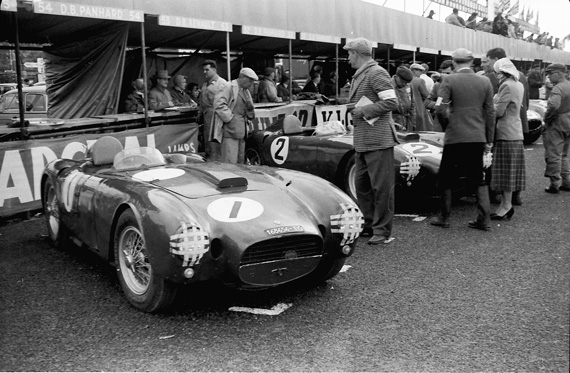
An excellent and very enjoyable article by Graham Gauld. Did he, will he do a full bio on Portago? I’d be the first to get one. His lean writing style gives the straight goods. I like that.
JF
Graham — Thanks very much for writing this excellent story for us. I have a trivia question. At the beginning of the piece, you say that Castelloti began racing at age 20. Was that the limit for racing in Italy? Or in Europe? Of course, here in the U.S., SCCA put it at 21. This was usually observed in the East and Midwest but on the West Coast drivers as young as 17 were pretending to be the legal age for racing. Any thoughts? All the best, Carl Goodwin
graham always does good stories on drivers from the past! castellotti was before my time but the drivers from the 50s/60s era are the ones im interested ! it seemed more pure then! another great story graham did was on giancarlo baghetti ! I learned more about him from reading grahams article then I ever learned elsewhere ! castellotti is one driver I would like to have met! this is just a suggestion for graham he might do a story on herbert mackay fraser an american driver long forgotten who died in july 1957 who raced in only one grand prix a week before he was killed in a race in france!!! it seems several others have expressed an interst in mackay fraser from some intenet postings ive seen !! so if your looking for another story to do graham I would really be interested in one where I could learn more about mackay fraser ! at any rate good health to you graham I contacted you once before regarding your articles!!!!!!!!!! the moment I see that you have written an article im going to readit for sure!!!!!!!
Another great story by Graham Gauld. I think Graham’s one of the premier writers today (and yesterday) with his easy going, unpretentious, informal style of story telling. If one considers him or herself a motor racing aficionado, they should have one of the best motor racing books written on the their shelf–Modena Racing Memories–published in 1999. Written by Graham Gauld.
Graham,
Thanks an excellent short history of Castelloti- always a hero in those mid 1950s.
You have great photos from the Dundrod TT. I spectated there in 1955 to see Moss, Fangio, Hawthorn, Titterington etc. Race full of sadness as well as excitement. I own a Frazer Nash that raced there in 1954 and wonder if you have other photos from that race.
Happy motoring
Robert
Wayne,
I think I wrote the Giancarlo Baghetti piece elsewhere and he was a real character, I last bumped into him at the Laguna Seca historics shortly before he died. He is the only racing driver who was later to become a photographer for Playboy magazine. Now there is a job that would have suited Innes Ireland !
As for Herbert McKay Fraser he was around but I never actually spoke to him so anything I wrote about him would be a bit second hand i am afraid.
GG
Carl Goodwin
Carl, I was not aware of the 20 year starting age for racing in Italy. Certainly in Britain you used to be able to start at 17 when you qualified for a road drivers licence but since lowered to 16 for certain classes of racing.
GG
J F Fontana
I think if I did a “Full” de Portago story it would fill Veloce Today for about two years as I once started out on a biography of him but a divorce got in the way. I will do a suitably shortened piece on him but meanwhile I could direct you to Ed biogrphy of de Portago which is excellent.
GG
Great read. I owned 1950 Ferrari 166MM Touring Barchetta s/n 0058M for 22 years. It was Castellotti’s first race car as discussed in the article. It was considered the most original Barchetta in existance. I sold it with the words that everything worked and nothing should be changed.
Ferraris are meant to be driven. I regularly drove the car and ran it in both the Colorado Grand and the California Mille. Sherman Wolfe co-drove with me one year and coaxed power and speed out of the little boat that pleasantly surprised me. Gino, our Barchetta named after Castellotti, loved it.
The next time we saw the car after we had sold it to a major collector, it had been given a ground up restoration. I was stunned and my wife Sherry cried. It is no longer Gino. It is no longer Castellotti’s car. It is now a brand new 166MM Touring Barchetta. History has been destroyed. I should have never sold it.
Dear Mr. Gauld:
I was wondering if you might be able to shed some light on a minor, but somewhat interesting inquiry. Were there any allegations that Enzo Ferrari became, for a time, romantically involved with Delia Scala, Eugenio Castellotti’s girl friend, after he was tragically killed. I seem to have come across some account of this, probably on the internet, but now cannot locate this reference. Thank you.
Many tks ! Just a couple of comments:
– At the Spanish GP, the last one of ’54 season, Lancia came with two iconic D50 (chassis nº 0001 and 0002), for Ascari and Villoresi respect.: they were fast but fragile and both retired early.
– There is a Castellotti biography titled “Un cuore rubato”, writen in Italian language, by noted historian Cesare de Agostini